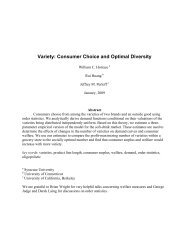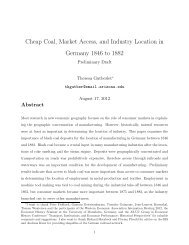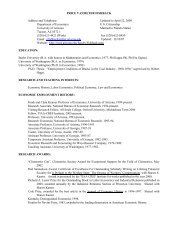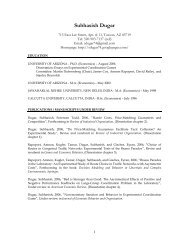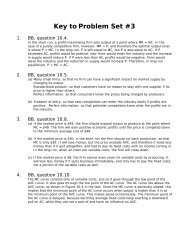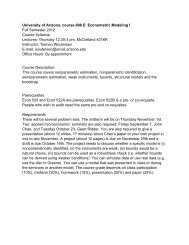A Dynamic Model of Demand for Houses and Neighborhoods
A Dynamic Model of Demand for Houses and Neighborhoods
A Dynamic Model of Demand for Houses and Neighborhoods
Create successful ePaper yourself
Turn your PDF publications into a flip-book with our unique Google optimized e-Paper software.
v MC<br />
�<br />
j (sit, ζit) = uijt − MCitI [j�=dit−1] + βE<br />
where<br />
log � J �<br />
k=1<br />
log � J �<br />
k=1<br />
exp(v MC<br />
k (sit, ζit)) � �<br />
� �<br />
= Eɛ V (sit, ζit, ɛit) = Eɛ<br />
exp(v MC<br />
k (sit+1, ζit+1)) �� �<br />
�<br />
�sit, dit = j<br />
maxk[v MC<br />
k<br />
�<br />
(sit, ζit) + ɛikt]<br />
Similarly to the per-period utility, we break out the full choice specific value function into a<br />
component capturing the lifetime expected utility <strong>of</strong> choosing neighborhood j ignoring moving<br />
costs <strong>and</strong> another component involves moving costs.<br />
4 Estimation<br />
v MC<br />
j (sit, ζit) = vj(sit) − MC(Zit, Xdit−1t, ζit)I [j�=dit−1] (6)<br />
�<br />
vj(sit) = uijt + βE log � J �<br />
exp(v MC<br />
k (sit+1, ζit+1)) �� �<br />
�<br />
�sit, dit = j<br />
k=1<br />
The estimation <strong>of</strong> the primitives <strong>of</strong> the model proceeds in four stages. In the first stage, we<br />
recover the non-moving cost component <strong>of</strong> lifetime expected utility. In the second stage, we<br />
recover moving costs. We also recover an estimate <strong>of</strong> the marginal utility <strong>of</strong> wealth. While<br />
a number <strong>of</strong> st<strong>and</strong>ard options <strong>for</strong> estimating the marginal utility <strong>of</strong> wealth are available, we<br />
identify the marginal utility <strong>of</strong> wealth by utilizing outside in<strong>for</strong>mation on the financial costs <strong>of</strong><br />
moves. Having recovered moving costs <strong>and</strong> the marginal utility <strong>of</strong> wealth in the second stage, we<br />
recover fully flexible estimates <strong>of</strong> the per-period utility in the third stage. With estimates <strong>of</strong> the<br />
per-period utility function, it is straight<strong>for</strong>ward to decompose per-period utility as a function<br />
<strong>of</strong> observable states in the fourth stage. A key feature <strong>of</strong> our estimation strategy is its low<br />
computational burden.<br />
18<br />
(5)<br />
(7)



